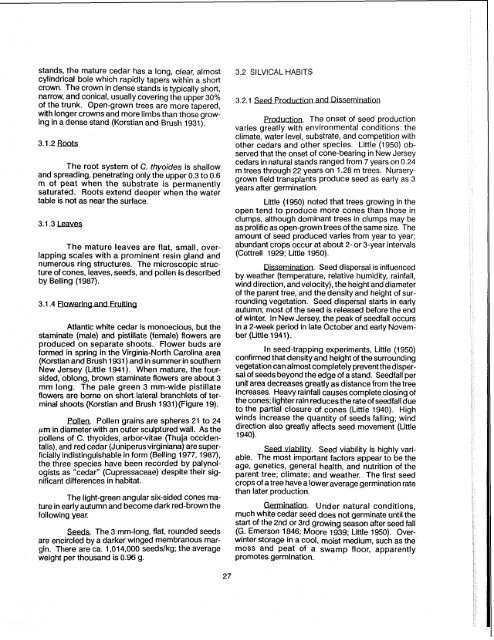The ecology of Atlantic white cedar wetlands - USGS National ...
The ecology of Atlantic white cedar wetlands - USGS National ...
The ecology of Atlantic white cedar wetlands - USGS National ...
You also want an ePaper? Increase the reach of your titles
YUMPU automatically turns print PDFs into web optimized ePapers that Google loves.
stands, the mature <strong>cedar</strong> has a long, clear, almostcyiindrical bole which rapidly tapers within a shortcrown. <strong>The</strong> crown in dense stands is typically shorl,narrow, and conical, usually covering the upper 30%<strong>of</strong> the trunk. Open-grown trees are more tapered,with longer crowns and more limbs than those growingin a dense stand (Korstian and Brush 1931).<strong>The</strong> root system <strong>of</strong> C. thyoides is shallowand spreading, penetrating only the upper 0.3 to 0.6rn <strong>of</strong> peat when the substrate is permanentlysaturated. Roots extend deeper when the watertable is not as near the surface.<strong>The</strong> mature leaves are flat, small, overlappingscales with a prominent resin gland andnumerous ring structures. <strong>The</strong> microscopic structure<strong>of</strong> cones, leaves, seeds, and pollen is describedby Belling (1 987).<strong>Atlantic</strong> <strong>white</strong> <strong>cedar</strong> is monoecious, but thestaminate (male) and pistillate (female) flowers areproduced on separate shoots. t lower buds areformed in spring in the Virginia-North Carolina area(Korstian and Brush 1931) and in summer in southernNew Jersey (Little 1941). When mature, the foursided,oblong, brown staminate flowers are about 3mm long. <strong>The</strong> pale green 3 mm-wide pistillateflowers are borne on short lateral branchlets <strong>of</strong> terminalshoots (Korstian and Brush 1931)(Figure 19).Pollen. Pollen grains are spheres 21 to 24pm in diameter with an outer sculptured wall. As thepollens <strong>of</strong> C. thyoides, arbor-vitae (l'huja occidentalis),and red <strong>cedar</strong> (Juniperusvirginiana) are superficiallyindistinguishable in form (Belling 1977, 1987),the three species have been recorded by palynologistsas "<strong>cedar</strong>" (Cupressaceae) despite their significantdifferences in habitat.<strong>The</strong> light-green angular six-sided cones maturein early autumn and become dark red-brown thefollowing year.Seeds. <strong>The</strong> 3 mm-long, flat, rounded seedsare encircled by a darker winged membranous margin.<strong>The</strong>re are ca. 1,014,000 seedslkg; the averageweight per thousand is 0.96 g.3.2 SILVICAL HABITS3.2.1 Seed Pr-. .-. <strong>The</strong> onset <strong>of</strong> seed productionvaries greatly with environmental conditions: theclimate, water level, substrate, and competition withother <strong>cedar</strong>s and other species. Little (1950) observedthat the onset <strong>of</strong> cone-bearing in New Jersey<strong>cedar</strong>s in natural stands ranged from 7 years on 0.24m trees through 22 years on 1.28 m trees. Nurserygrownfield transplants produce seed as early as 3years after germination.Little (1950) noted that trees growing in theopen tend to produce more cones than those inclumps, although dominant trees in clumps may beas prolific as open-grown trees <strong>of</strong> the same size. <strong>The</strong>amount <strong>of</strong> seed produced varies from year to year;abundant crops occur at about 2- or 3-year intervals(Cottrell 1929; Little 1 950).-. Seed dispersal is influencedby weather (temperature, relative humidity, rainfall,wind direction, and velocity), the height and diameter<strong>of</strong> the parent tree, and the density and height <strong>of</strong> surroundingvegetation. Seed dispersal starts in earlyautumn; most <strong>of</strong> the seed is released before the end<strong>of</strong> winter. In New Jersey, the peak <strong>of</strong> seedfall occursin a 2-week period in late October and early November(Little 1941).In seed-trapping experiments, Little (1950)confirmed that density and height <strong>of</strong> the surroundingvegetation can almost completely prevent thedispersal<strong>of</strong> seeds beyond the edge <strong>of</strong> a stand. Seedfall perunit area decreases greatly as distance from the treeincreases. Heavy rainfall causes complete closing <strong>of</strong>the cones; lighter rain reduces the rate <strong>of</strong> seedfall dueto the partial closure <strong>of</strong> cones (Little 1940). Highwinds increase the quantity <strong>of</strong> seeds falling; winddirection also greatly affects seed movement (Little1 940).-. Seed viability is highly variable.<strong>The</strong> most important factors appear to be theage, genetics, general health, and nutrition <strong>of</strong> theparent tree; climate; and weather. <strong>The</strong> first seedcrops <strong>of</strong> a tree have a lower average germination ratethan later production.m.. .Under natural conditions,much <strong>white</strong> <strong>cedar</strong> seed does not germinate until thestart <strong>of</strong> the 2nd or 3rd growing season after seed fall(G. Emerson 1846; Moore 1939; Little 1950). Overwinterstorage in a cool, moist medium, such as themoss and peat <strong>of</strong> a swamp floor, apparentlypromotes germination.

















